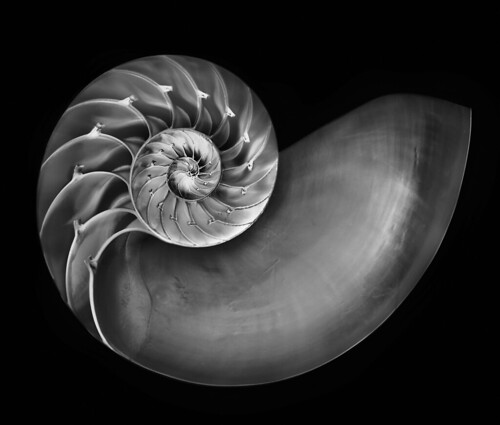
Nautilus in Black and White, photo by Harold Davis. View this image larger.
Finley Eversole contacted me for permission to use one of my chambered nautilus images in his book Art, Death and Transformation, to be published by Inner Traditions in 2009. Based on my conversation with Finley, he’s a man with personal experience of the abstract expressionists. I gather that his book is about the relationalship of the spiritual to art, particularly in the context of mid-twentieth century art. There’s an extensive discussion of Robert Smithson’s famous Spiral Jetty, constructed in 1970 and located in the Great Salt Lake, Utah.
In the context of Spiral Jetty, Finley wanted to illustrate spirals in nature, hence my chambered nautilus image. The catch was that he could only reproduce my image in black and white. Here’s the original image in color (you may notice that the black and white version is rotated).
I undertook the conversion to black and white myself because I was afraid that anything like a straight RGB to Grayscale switch would result in a murky image that lacked contrast. Converting RGB to Grayscale simply throws away the color information in the image, much as will happen when you discard the AB channels in LAB mode. Getting a little more sophisticated than this, I converted using a black and white adjustment layer. On the default settings, the results were predicably flat. Using the so-called Ansel Adams settings (explained here) and a channel mixer adjustment layer, I got slightly better results. By the way, my new book Light & Exposure for Digital Photographers from O’Reilly includes a case study that visually shows the impact of various black and white conversion techniques.
So I realized I needed to do a great deal of preparation, and essentially change the contrast structure of the image, before discarding the color information. I put the image through a variety of steps, but the most effective was the selective deployment in tritone mode (also explained in Light & Exposure and see Toned), using black, white, and Pantone metallic silver as the three colors.
By the way, I am planning to make prints of both the black & white and color versions of this image, so please let me know if you have an interest in owning a print.
I’ll leave the last words to Finley Eversole:
The spiral represents the unfolding of our hidden creative powers and symbolizes both self-realization and boundless expansion. Its secret is beautifully dramatized by the chambered nautilus whose in-dwelling life unfolds cyclically and periodically, mirroring in itself the expanding spirals and eternal patterns of the evolving cosmos.
Related stories: Nautilus 69, Spirals, Resistance to Spirals is Futile.
Harold Davis
28 Mar 2008Here’s more about Finley Eversole and his book:
FINLEY EVERSOLE, Ph.D., has taught and lectured widely on the arts, philosophy, psychology, metaphysics, creativity and meditation. His first foray into the arts and religion field was a book titled Christian Faith and the Contemporary Arts, 1962, after which he served as Executive Director of the Society for the Arts, Religion and Contemporary Culture, working with such people as Joseph Campbell and Alfred H. Barr, Jr. Art, Death and Transformation moves well beyond his early work and sets forth a new aesthetic and approach to art, striking a keynote intended to guide artists into the Aquarian Age.
ART, DEATH AND TRANSFORMATION: The Journey of the Twentieth Century from Existential Despair to Spiritual Awakening is a meditation on art and cultural transformation and a spiritual journey in which the reader is invited to participate. Built around a study of the visual arts from 1945 onward, the book draws extensively on philosophy, psychology, myth and symbolism, literature, metaphysics and personal experience to explain the seven stages of spiritual death and rebirth. This book does via the visual arts something akin to what Joseph Campbell does in The Hero with a Thousand Faces. The reader is guided through the experience of self-loss, the journey into the underworld, the experience of the dark night of the soul, the conflict with and triumph over evil, the awakening of new life in the depths of being, and the return and reintegration of consciousness on a higher plane of being, resulting finally in ecstasy, transfiguration, illumination and liberation. Based on in-depth studies of individual works of art, these themes are approached so as to allow a slow building of insights aimed at nurturing in readers a new type of consciousness. The author sees in death and rebirth, as mirrored in the arts, a foreshadowing of profound social change and cultural renewal.
Art is a moment of awakening, a record of ecstasy, a revelation of mystery, a ritual of rebirth, a recovery and realization of childhood, a return to eternal origins…. It is a powerful and liberating force in the evolution of human consciousness.
FROM THE CONCLUDING CHAPTER
Pingback: Photoblog 2.0: » Photoblog 2.0 Archive: » Monochrome Shore
Pingback: Photoblog 2.0: » Photoblog 2.0 Archive: » Cala Lily Flute
Pingback: Photoblog 2.0: » Photoblog 2.0 Archive: » Glory
Pingback: Black and White for the Digital Era | Photoblog 2.0
Pingback: Poppy Core | Photoblog 2.0
Pingback: Nautilus Shell and Rope | Photoblog 2.0
Pingback: Nautilus Cross Section | Photoblog 2.0
Pingback: Nautilus by Halves
Pingback: Human Spiral—Nautilus